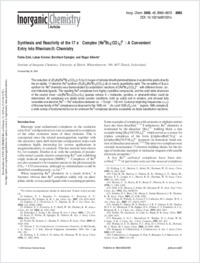Synthesis and reactivity of the 17 e- complex [Re(II)Br4(CO)2]2- : A convenient entry into rhenium(II) chemistry
- Zobi, Fabio University of Fribourg
- Kromer, Lukas University of Zurich
- Spingler, Bernhard University of Zurich
- Alberto, Roger University of Zurich
-
2009
Published in:
- Inorganic Chemistry. - 2009, vol. 48, no. 18, p. 8965-8970
English
The reduction of (Et(4)N)[Re(III)Br(4)(CO)(2)] (1) by 0.5 equiv of tetrakis- dimethylaminoethylene in acetonitrile yields directly the air-stable, 17-electron Re(II) synthon (Et(4)N)(2)[Re(II)Br(4)(CO)(2)] (2) in nearly quantitative yield. The versatility of 2 as a synthon for Re(II) chemistry was demonstrated by substitution reactions of [Re(II)Br(4)(CO)(2)](2-) with different mono-, bi-, and tridentate ligands. The resulting Re(II) complexes form highly crystalline compounds, and the solid state structures of the neutral trans-cis-[Re(II)Br(2)(CO)(2)(X)(n)] species (where X = imidazole, pyridine, or phenanthroline) could be determined. All complexes are stable under aerobic conditions, both as solids and in solution, and showed fully reversible one-electron Re(II) --> Re(I) reductions between ca. -70 and -120 mV. Carbonyl stretching frequencies (nu(CO)) of this new family of Re(II) complexes are observed in the 1990 cm(-1) (A(1)) and 1830 (E(g)) cm(-1) regions. With complex 2, a wide variety of fundamental but so far unknown Re(II) complexes become accessible via facile substitution reactions.
- Faculty
- Faculté des sciences et de médecine
- Department
- Département de Chimie
- Language
-
- English
- Classification
- Chemistry
- License
-
License undefined
- Identifiers
-
- RERO DOC 330340
- DOI 10.1021/ic901031x
- Persistent URL
- https://folia.unifr.ch/unifr/documents/309211
Statistics
Document views: 138
File downloads:
- Fichier principal: 245
